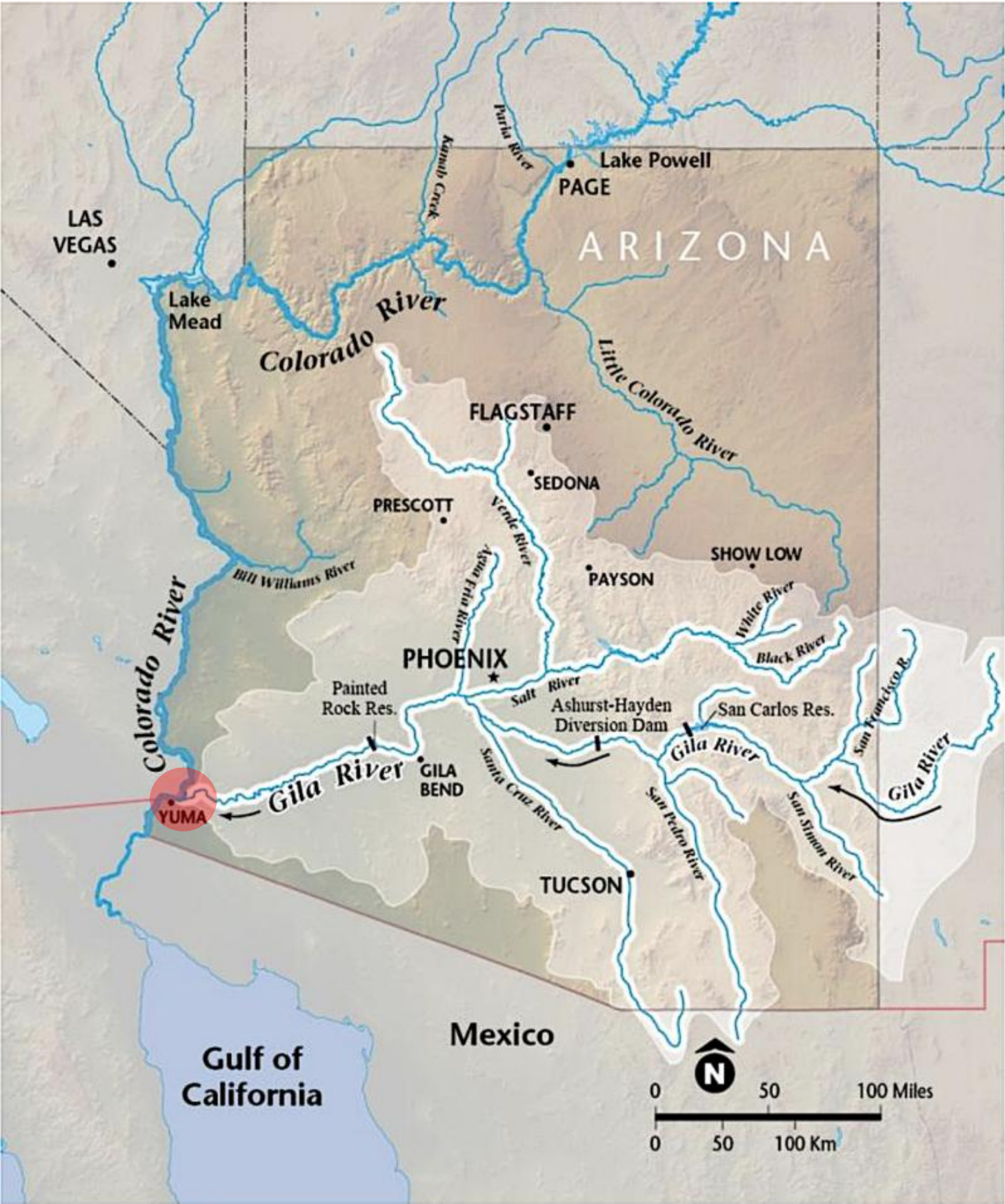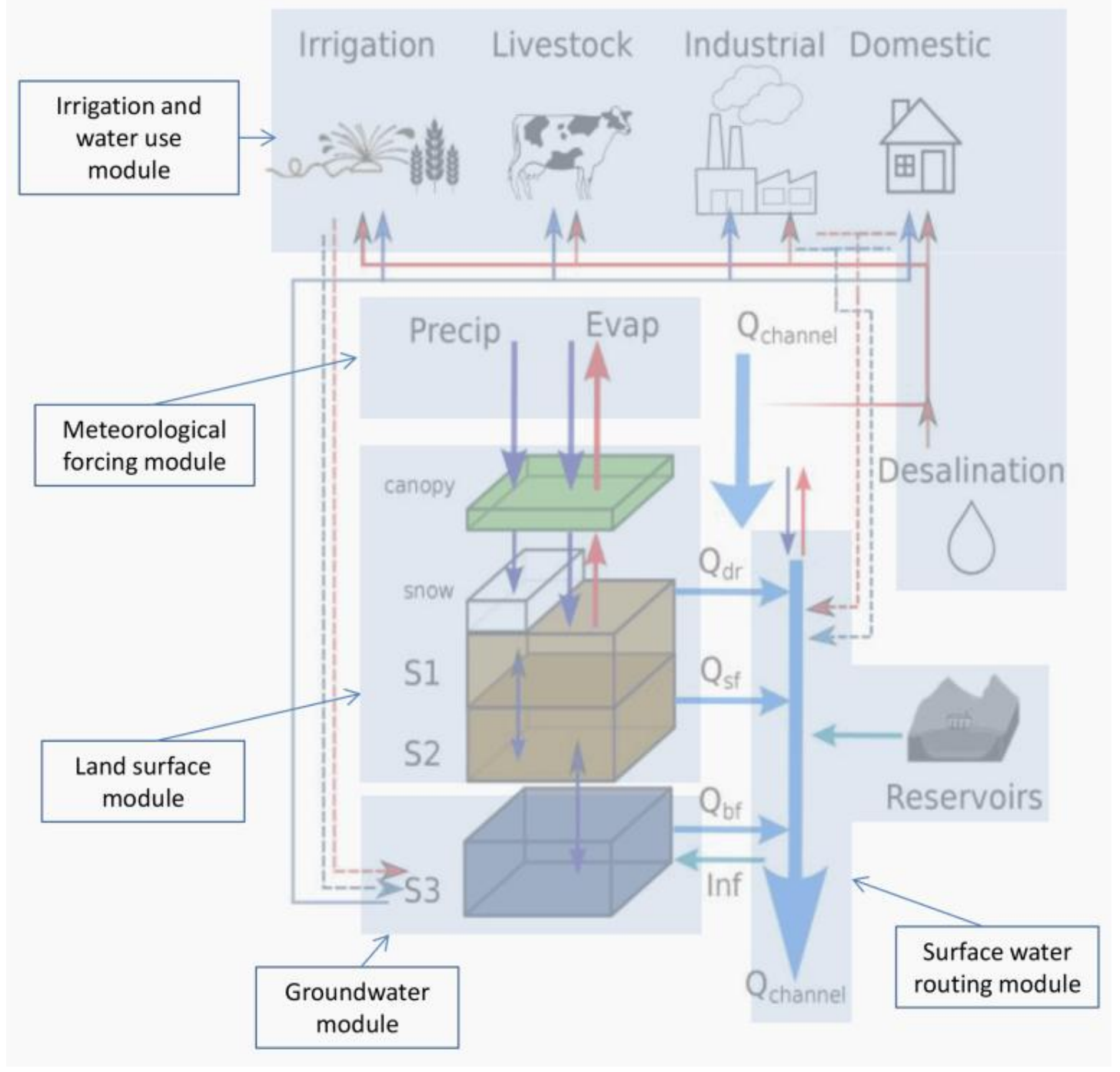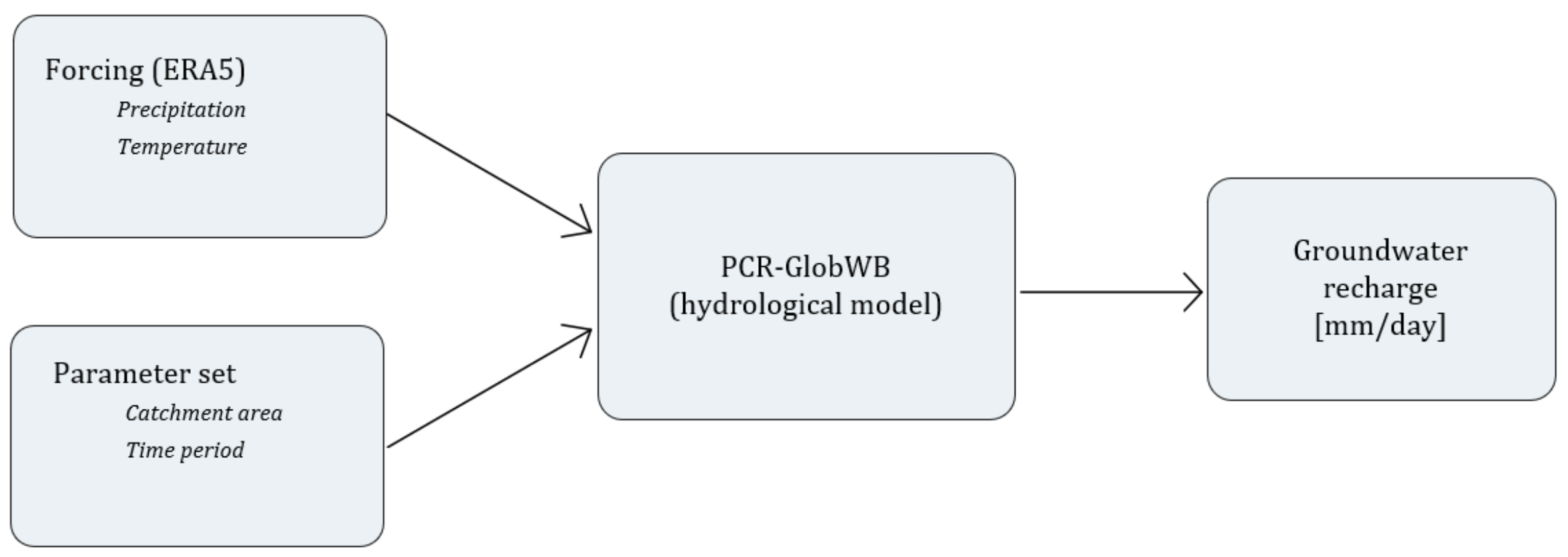Methodology#
The chapter outlines the methods used to analyse the impact of climate change on groundwater recharge. First, Section 2.1 discusses the study area. Section 2.2 focuses on the hydrological model PCR-GlobWB. Section 2.3 discusses the climate projections and the application of CMIP6. Lastly, in Section 2.4 the water balance in the study area is discussed.
Study area#
The Sonoran Desert is an arid region with a subtropical climate in the Southwestern of the United States and Northwestern of Mexico. According to the National Park Service (NPS, 2024) the desert covers approximately 260 000 km2 of this region, as shown in Figure 1. In this region, the hydrological system includes many streams and two primary rivers, the Colorado River and the Gila River, Figure 2. A majority of the smaller streams remain dry for most of the year (Kampf et al., 2018).
 Figure 2: Rivers in Arizona (Robbins & Wood, 2021). Copyright © 2025 Environmental Defense Fund. Used by permission. The original material is available at http://edf.org.
Figure 2: Rivers in Arizona (Robbins & Wood, 2021). Copyright © 2025 Environmental Defense Fund. Used by permission. The original material is available at http://edf.org.
The Sonoran Desert receives an average annual precipitation of 76-500 mm. Majority of the rainfall occurs during the summer monsoon thunderstorms. However, it also receives frequent low-intensity winter rains and a significant amount is occurring as snowfall at higher elevations. Precipitation is an important factor to recharge groundwater. Another critical factor is temperature, which influences the rate of evapotranspiration. High temperatures increase the rate of evapotranspiration, reducing the amount of water available for groundwater recharge (Dimitriadou & Nikolakopoulos, 2021). During the summer, air temperatures exceed 40°C. The temperatures in the winter are mild and mostly free of frost (NPS, 2024).
The Gila River spans a greater stretch within the Sonoran Desert compared to the Colorado River (Figure 2). The Colorado River extends to the Rocky Mountains and flows through multiple regions, which can be categorized into the Upper basin and the Lower basin. The discharge in the basins is influenced by several factors, including the milder temperatures and the amount of precipitation (Salehabadi et al., 2020). Appendix B provides figures with the mean temperature, mean precipitation and mean runoff of the two basins. Since many factors influencing the discharge of the Colorado river originate outside the Sonoran Desert, this research focuses on the Gila River. The rivers converge near the city Yuma, which is highlighted in Figure 2.
This study simplified the groundwater flow by assuming it occurs in a single direction, along the streamflow of the Gila River. This will simplify the results. However, in reality the groundwater flow is often a multiple directions and is influenced by several factors (USGS, n.d.).
PCR_GlobWB#
This study will focus on the impact of climate change on the groundwater recharge in the Sonoran Desert. To assess the impact, the eWaterCycle platform will be used. In eWaterCycle, hydrological models are made FAIR (findable, accessible, interoperable and reproducible) by adding a Basic Model Interface (BMI). These models can be run through the open interface of eWaterCycle and run using Jupyter notebooks provided by the platform. The eWaterCycle platform currently supports the following hydrological models: PCR-GlobWB, wflow, Hype, LISFLOOD, MARRMoT and WALRUS. To predict the effects on the groundwater recharge, the PCR-GlobWB model will be used (Hut et al., 2022).
The PCR-GlobWB model is a grid based, global hydrology and water resources model. Because the computational grid covers all the continents, except Greenland and Antarctica, it can be used to simulate the area of the Sonoran Desert (Sutanudjaja et al., 2018).
The PCR-GlobWB model incorporates various aspects of water use, including sector specific water demand, groundwater and surface water withdrawals, water consumption and return flows. It is capable of simulating soil moisture storage and the exchange of water between the soil, atmosphere and the underlying groundwater reservoir. The components enable the model to estimate groundwater recharge. All of these processes are computed at each time step and are integrated into the simulated hydrology. However, certain factors in the model, such as irrigation, stay constant over time (Sutanudjaja et al., 2018). This limitation should be considered when interpreting the simulated outputs.
 Figure 3: PCR-GlobWB 2.0 cell (Sutanudjaja et al., 2018).
Figure 3: PCR-GlobWB 2.0 cell (Sutanudjaja et al., 2018).
In Figure 3 a simplified overview of a PCR-GlobWB cell can be found to give an impression of all the fluxes in a system. In this figure, the thin red and blue line indicate surface water withdrawal and groundwater extraction, respectively. The dashed lines indicate return flows. PCR-GlobWB simulates at a spatial resolution of 5 arc-minute, which is ~10x10 km at the equator (Sutanudjaja et al., 2018).
Historical Data#
The hydrological models on the eWaterCycle platform generally need two inputs: a forcing and a parameter. Forcings are defined as a time-varying input. In contrast, a parameter is a constant input (Hut et al., 2022). The parameter input is the time that needs to be simulated and the catchment area, in this case the Sonoran Desert. This input remains the same for the historical data and for the climate projections.
The forcing input for hydrological models such as PCR-GlobWB in eWaterCycle is derived from ERA5 datasets (Hut et al., 2022). ERA5 offers comprehensive recorded data on the global atmosphere, the land surface and ocean waves from 1950 to the present (Hersbach et al., 2020). To prepare the ERA5 dataset for direct application in the PCR-GlowbWB model, the ESMValTool in eWaterCycle is enabled. In this research, precipitation and temperature serve as the input for forcing. Additionally, a parameter set including is required as model input, which includes the catchment area and the time period (Hut et al., 2022). Figure 4 presents a flow chart of the PCRGlobWB model, with ERA5 and a parameter set as input.
 Figure 4: PCR-GlobWB flowchart (ERA5).
Figure 4: PCR-GlobWB flowchart (ERA5).
Climate Projections#
To evaluate the potential impact of climate change, the Coupled Model Intercomparison Project Phase 6 (CMIP6) will be used for climate simulations. Three Shared Socioeconomic Pathways (SSPs) are selected for analysis: SSP1-2.6, SSP2-4.5 and SSP5-8.5. These pathways correspond to an optimistic scenario limiting the future warming to 1.3-2.4°C, a middle road limiting the warming to 2.1-3.5°C and the worst-case scenario which limits the future warming to 3.3-5.7°C in 2100, respectively (Masson-Delmotte et al., 2021). Appendix A explains the narratives of each of the selected SSPs and contains a graph of the increase of CO2 emissions and global mean temperature. The mentioned SSPs is used as forcing input to simulate the future groundwater recharge. Figure 5 provides a flowchart of the PCR-GlobWB model with CMIP6 as forcing input.
 Figure 5: PCR-GlobWB flowchart (CMIP6).
Figure 5: PCR-GlobWB flowchart (CMIP6).
Water Balance#
As outlined in Sections 2.2 and 2.3, the requested output ofthe PCR-GlobWB model is groundwater recharge. To validate the groundwater recharge values obtained, a water balance is assessment is required. A water balance represents the water input and water output within a system (Srivastava et al., 2020). For the Gila River basin, the water balance components include the change in groundwater storage (ΔS), the minimum river discharge (Q), the average precipitation (P), the average surface runoff (R), the average evaporation transpiration (ET) and agricultural water extraction (Agr). The water balance is given by Equation 1:
The mean annual change in groundwater storage is -0.2 m/year (Arizona Groundwater Dashboard, 2024). In arid regions on regional scale, the baseflow of rivers is often indicative of the minimum groundwater recharge that is required to sustain streamflow (Schilling et al., 2021). The baseflow of the Gila River near Yuma is 0 ft3/s (USGS, n.d.). According to the maps provided in Appendix B, the mean annual precipitation is 15 in/year and the mean annual runoff is 0 in/year. The groundwater extraction for agricultural use is 1.15 MAF/year (ADWR, 2022). The mean annual evapotranspiration in the Santa Cruz aquifer is estimated at 8.83*106 m3/year (TapiaVillaseñor, 2022). As this region lies within the Sonoran Desert, it is assumed that similar climatic conditions lead result in comparable evapotranspiration rates. Therefore, the evapotranspiration of Santa Cruz aquifer has been scaled proportionally to estimate the evapotranspiration for the Gila River basin. The evapotranspiration and the other values are summarized in Table 1. The derivations of the values of the metric system are explained in Appendix C.
Table 1: Input water balance in imperial units and metrical units.
Imperial units |
Metrical units [m³/year] |
|
|---|---|---|
\(\Delta S\) |
-0.6 [in/year] |
\(-3×10^9\) |
\(Q\) |
0 [ft³/s] |
\(0\) |
\(P\) |
15 [in/year] |
\(5.9×10^10 \) |
\(R\) |
0 [in/year] |
\(0\) |
\(ET\) |
- |
\(4.05×10^8\) |
\(\text{Agr}\) |
1.15 [MAF/year] |
\(1.42×10^9\) |
Based on the values in Table 1 and using Equation 1, the groundwater recharge is calculated to be \(-0.29\) \(m/year\) (\(-0.78\) \(mm/day\)). A positive value would indicate an increase in groundwater recharge. However, this negative value indicates a decrease in groundwater recharge. Since this value is derived from observations and measurements, this value is used to validate the simulated output generated by PCR-GlobWB.
The water balance is also be applied while performing the simulation, to further validate the simulated groundwater recharge. Using the available corresponding variables from PCR-GlobWB, the following are in the water balance: precipitation (P), total evaporation (E), total groundwater abstraction (Abs), land surface runoff (R) and discharge (Q). These values are used to approximate the simulated groundwater recharge, as represented in Equation 2:
A flowchart to obtain the approximated groundwater recharge is given in figure 6. This is simulated for both ERA5 and CMIP6.
 Figure 6: PCR-GlobWB flowchart (approximated groundwater recharge).
Figure 6: PCR-GlobWB flowchart (approximated groundwater recharge).
